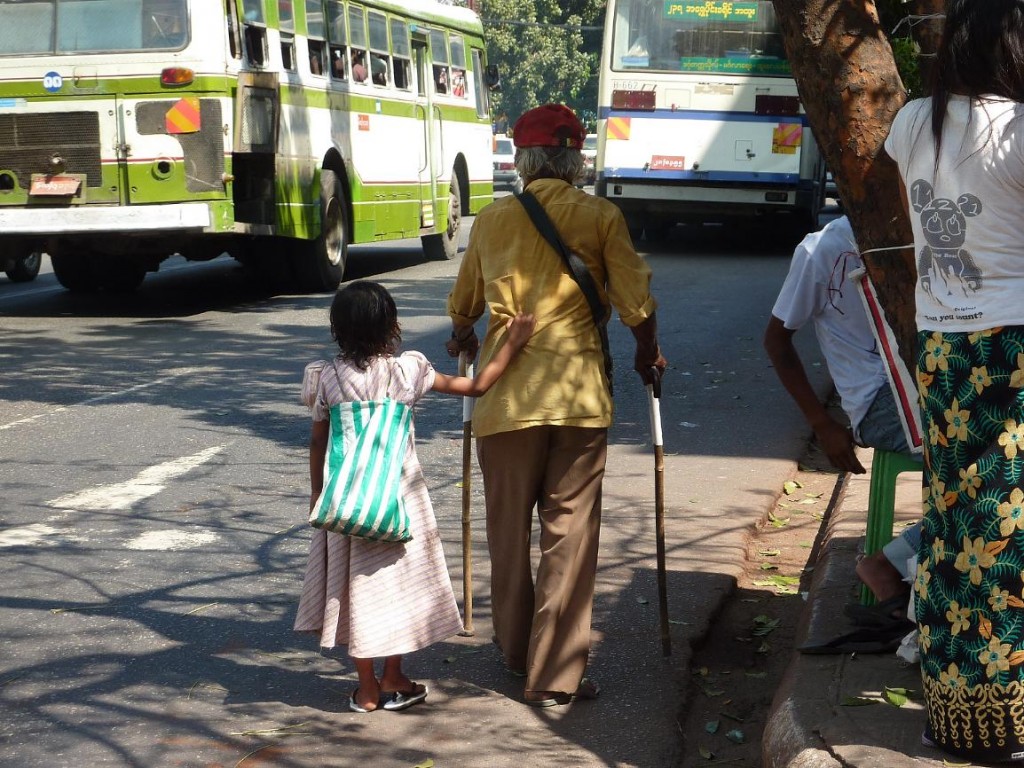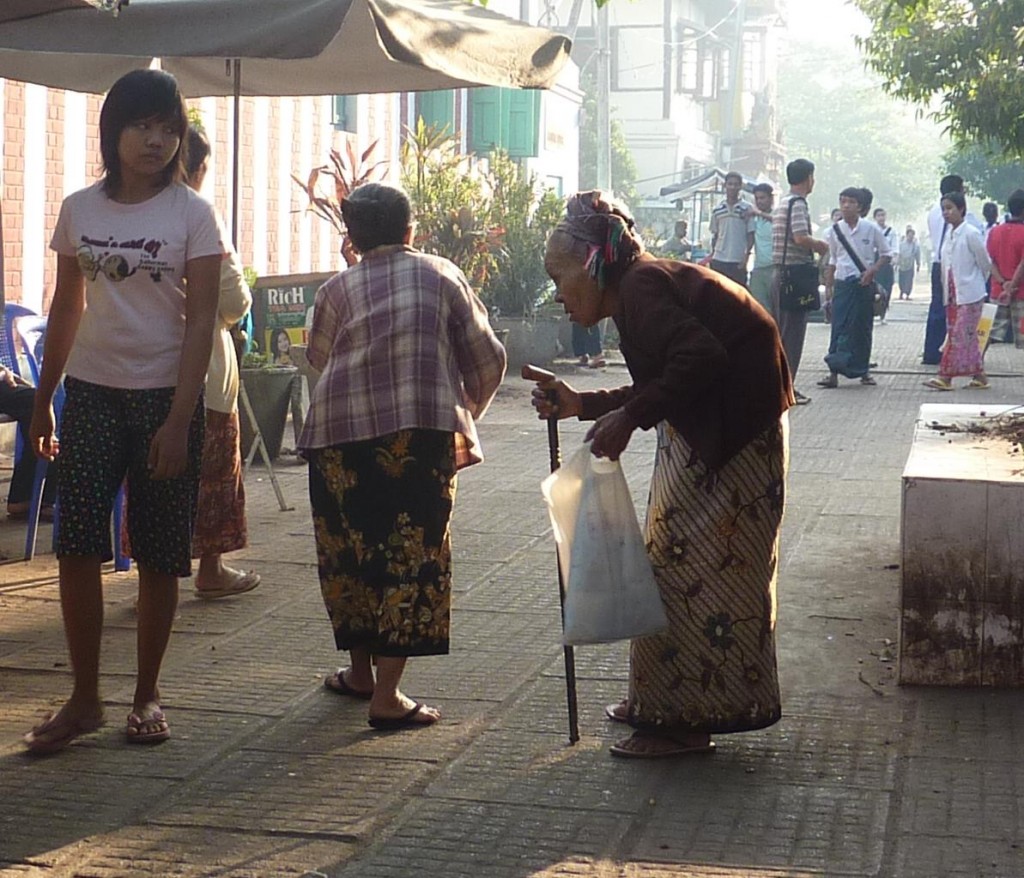In Yangon, near the downtown, the side streets are lined with apartments stacked almost always exactly seven floors above the ground level. At the front is a porch area, usually hanging with drying laundry, mostly barred, and also with barred windows. From each porch hangs a string which reaches to the street below. Attached will be a strong clip, or sometimes a plastic carry bag.
There are roving vendors in the street below, calling out the name of what they are selling – if a man usually on shoulder poles, if a woman typically in a tray carried on the head. The resident sitting out on the porch calls down, and the item to be purchased is placed in the plastic purse or clipped to the string. When the string is lowered back down, the vendor receives the pay, and continues on.
When a visitor arrives, he pulls the string which rings a bell above. The resident then pulls up the string and clips to it the key. Yangon doorman.
————-
The buses in Yangon are the ultimate wild ride. When they stop, the conductor jumps out and he grabs each person loading by the arm to hurry them in and up. As the last two are boarding, the bus is already lurching forward. This photo was taken on Mahabandoola Street in Yangon where the buses can be nose to tail for several blocks as they jostle for a space at the ‘bus stop’. They squeeze and push, and adjacent taxis and pedestrians have to carefully watch themselves to keep from getting squashed.
This elderly man was walking with two canes. The little girl, likely his granddaughter, must have had clear unequivocal instructions to hang on to him as he had no arms free to protect her. When I took this photo, he was about to launch himself, and her, across this bus-mobbed street. Experience matters. Moments later he had walked them across to the other side – a truly impressive performance.
————–
Buddhism is a complex and wondrous part of Myanmar. It earns merit to give. On the streets there are dense flocks of pigeons. I am conditioned from growing up in San Francisco to regard them as filthy birds. Here these flocks mark the presence of little stands where cups of bird feed are sold. A purchase of a cup of food might be made by a passing monk, by any Buddhist seeking merit, or by someone who actually cares. The monk throws the feed all at once and, without breaking stride, moves on, thus earning merit by caring for these creatures.
A woman is walking with her daughter. The mother might be sixty or so – people’s hair barely grays here so it is hard to tell. The daughter appears to be in her early to mid-forties. The lady is quite clearly, fairly severely, humpbacked. She stops at the pigeon lady and buys a plate of grain. Unlike the monk, she offers it slowly, with one pigeon perched on her plate. She earns her merit, but with joy.
What happens next deeply touches my heart. On the street a bit further along, by the bus stopping place, is a much older woman, severely humpbacked, bent painfully, who walks slowly leaning on a cane. She carries a plastic bag. The kind hearts among the pedestrians put a small sum of kyat into her bag. There is no welfare here, and she must have no family. This is Buddhist welfare.
And what moves me so is that I see this younger humpbacked lady stop to fish in her purse, and leaning on her daughter push some notes into this plastic bag. She walks on quickly; it is in contrast to the slow way that she had fed the pigeons. And I can feel her heart, that she knows that she lives in grace, with the same affliction, knowing that in some number of years more, she will be physically the same, but with the crucial difference that she has this loving daughter holding her arm.
Near where the pigeon food seller is sitting is a water stand which will presumably have safe water. The seller has set a bowl of water on the pavement; she is Buddhist, not simply finding a way to feed her family. She gives the birds clean water with their food. There is a sense of bond, a gratitude that is conveyed in this gesture.
———–
But there are some things in this merit system which puzzle me. I tried in vain to ask this of a young man, devoutly Buddhist and with very good English, and my question made no sense at all to him. Some sellers walk around with a variety of small caged birds. it earns merit to buy and release them. But what I do not understand is, if it earns merit to release the caged bird, what does it earn to imprison it in the first place?
———-
And a few days later I have my answer from the Buddhist perspective: the seller gives the opportunity to earn merit and thus earns merit himself. That is what I so love about travel, one’s perspective must grow and change. But though I begin to understand the Buddhist perspective in this, one must look at the actions of the privileged here – at the belief that any amount of cruelty can be counterbalanced at the end by building fancy temples. In my western view, what is taken from the people during a lifetime of terrible behavior cannot be undone with such falseness and posturing. So my western view remains, even as I understand more the local beliefs. Imprisoning the bird remains fundamentally wrong, in my mind.
On the streets of Mandalay
Mandalay – Streets



Thanks a lots .Its a very interesting outlook by a foreigner.Now a day there were some old aged caring centre are going to established in our country.I myself now taking part to care for the needy peoples in our surrounding.We are now looking to raise for funding our centre.
Hillary, perhaps we will have a chance to talk more about this in January.